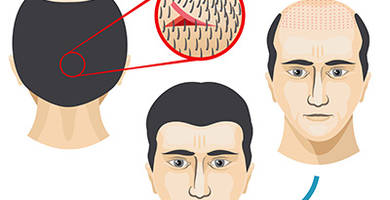Can scarring alopecia be stopped?
By Prof. Dr. Soner Tatlidede 2020-02-10

Scarring alopecia is a type of alopecia characterized by the arising of scar tissue preventing hair growth, and causing the irreversible destruction of hair follicles. Living with scarring alopecia is not something easy, and in the same way that happens with other forms of hair loss, scientific studies have shown that it can have a serious impact on patients' self-esteem, social experiences and quality of life.
In fact, many of the people interested in the cost of a hair transplant in Turkey are actually patients that have suffered from scarring alopecia. However, do you know what the causes of this disease are? Does scarring alopecia simply burn out, or does it need a treatment to stop it? If you are looking for answers about how to stop scarring alopecia from spreading, or about what are its symptoms and how to identify them... don´t miss the following lines.
Table of contents
How is scarring alopecia diagnosed?
The question is: can hair grow back after scarring alopecia? The bad news is that, as we mentioned before, once the scarring alopecia has caused the destruction of follicles, this is irreversible. That´s why it´s essential to identify and detect in time the symptoms of this disease. On the other hand, the good news is that scarring alopecia is usually located in a limited area of the scalp.
In scarring alopecia, the destruction of follicles is caused by an inflammation of the upper part of the hair follicle (which is where stem cells and sebaceous gland are located); however, this inflammation -that ultimately causes the atrophy of the follicle and its replacement by scar tissue- can sometimes become unnoticed at first, but there are other common symptoms like itching, burning, high sensitivity and even strong pain, together with hair loss.
In addition, the skin acquires a strange appearance, becoming atrophied and bright, making it impossible to pinch it; redness, scaling, decreased pigmentation and pustules may also appear as a result of the inflammation process that occurs under the scalp skin. Let´s remember that this process can happen both in men and women of any age, but it´s rare in children.
Therefore, it is vital to detect the inflammation of the follicles or any of these symptoms in time before follicles get destroyed. As scarring alopecia usually appears in form of bald spots, it can be sometimes confused with alopecia areata; so, if the symptoms are not clear you should consult a specialist, that can detect scarring alopecia by performing a biopsy in the scalp.
What causes scarring alopecia?
Scarring alopecia -also called scarring hair loss- can have multiple causes, therefore is not an easy task to identify its origin. Then, what causes scarring hair loss? Well, unlike other types of alopecia, this can appear due to genetic factors but also because of external ones, like infections or injuries. In summary, we can say that cicatricial alopecias are classified as primary or secondary:
- Primary: this scarring alopecia is produced mainly by genetic and hereditary factors, or other internal disorders that cause an alteration in the development of the follicle, its inflammation and finally its destruction.
- Secondary: the inflammation of the follicles is caused by a trauma or physical injuries (blows, wounds, burns, etc.), or by other external factors such as infections, tumours...
In fact, although in both cases the triggering factor of hair destruction is an inflammation of the follicles, secondary scarring alopecia is the most common type and can be consequence of all kinds of trauma, injuries, infections (both bacterial and viral), or even occur as a result of treatments, such as a surgery or radiation therapy.
Traction alopecia may also cause scarring alopecia. Traction alopecia commonly affects women wearing some traumatic hairstyles during long periods of time; and if this hairstyling continues and not adequate treatment is applied, the disease can continue advancing until become an scarring alopecia, causing irreversible damages to hair follicles.
How to reverse scarring alopecia
Then, questions arise: can scarring alopecia be stopped? How to treat scarring alopecia? We already mentioned that once the destruction of the follicle is done, it´s irreversible; but if we manage to identify symptoms and causes of the alopecia in time, there are treatments that can be very effective to prevent further damage to the rest of follicles.
Besides, doctors and scientists are working every day to learn how to stop scarring alopecia; for example, there have been some reports about the use of (Platelet Rich Plasma) for scarring alopecia with successful results that are quite promising, as well as those using medications such as minoxidil, too.
Anyway, as the damage to follicles is permanent, the best and most used solution nowadays for patients that have suffered from scarring alopecia is a hair transplant. At Clinicana we are specialists in all sorts of treatments, and we have the best professionals ready to diagnose your hair problems. Take a look at the reviews about hair transplant in Turkey, and find out why so many people have already trusted us for a permanent solution to save their hair.









